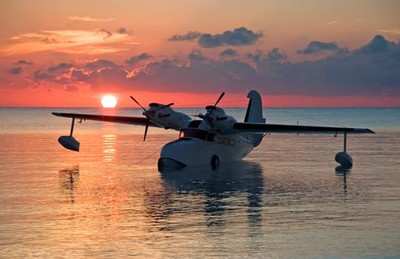Alaskan Landing Mishap Injured Nine
 Editor's Note: This is one
of the stranger Prelims we've come across lately. Below is the
unedited text of the National Transportation Safety Board's initial
findings regarding an April 9 landing accident in Unalaska, AK,
involving a Grumman G-21A Goose and a truck...
Editor's Note: This is one
of the stranger Prelims we've come across lately. Below is the
unedited text of the National Transportation Safety Board's initial
findings regarding an April 9 landing accident in Unalaska, AK,
involving a Grumman G-21A Goose and a truck...
NTSB Identification: ANC08FA050
Scheduled 14 CFR Part 135: Air Taxi & Commuter
Accident occurred Wednesday, April 09, 2008 in Unalaska, AK
Aircraft: Grumman G-21A, registration: N741
Injuries: 1 Serious, 8 Minor.
This is preliminary information, subject to change, and may
contain errors. Any errors in this report will be corrected when
the final report has been completed.
On April 9, 2008, about 1630 Alaska daylight time, an amphibious
Grumman G-21A airplane, N741, received substantial damage when it
collided with a trailer van while on approach to Runway 30 at the
Unalaska Airport, Unalaska, Alaska. The airplane was operated by
Peninsula Airways, Inc., Anchorage, Alaska. The flight was being
conducted under Title 14, CFR Part 135, as scheduled commuter
Flight 325, when the accident occurred. Of the nine people on
board, the airline transport pilot and seven passengers sustained
minor injuries, and one passenger sustained serious injuries.
Company flight following procedures were in effect. The flight
originated at the Akutan Sea Plane Base, Akutan, Alaska, about
1615, and was en route to Unalaska.
Airplanes landing at the Unalaska Airport on Runway 30 pass low
over Ballyhoo Road before reaching the approach threshold of the
runway. Ballyhoo Road provides the only access between the city of
Unalaska and the city dock facility, north of the Unalaska Airport.
Trucks transporting large container vans between the trailer yard
and the city dock facility routinely use the road. There are two
remotely controlled gates with warning lights on each side of the
runway threshold, designed to block vehicle traffic while airplanes
are landing on Runway 30. Additionally, when the gate and warning
light system is activated, the runway end identifier lights (REIL)
are also activated. Prior to landing, pilots are instructed to
activate the remotely controlled gate and warning light system.

Procedures for landing on Runway 30 are outlined in the Alaska
Flight Information Supplement, which states, in part: "Stop light
for vehicle traffic crossing Runway 30 threshold must be activated
and deactivated for each aircraft operation over the threshold."
Additionally, it states: " ...stop light for vehicle traffic
crossing Runway 30 threshold, key 122.6 7 times for on, 3 times for
stop light and REIL off."
 During a telephone interview with
the National Transportation Safety Board (NTSB)
investigator-in-charge (IIC) on April 10, the truck operator
reported that he was transporting a 45-foot long trailer van from
the Horizon Lines trailer yard to the city dock facility. He said
that as he approached the part of the road where it crossed under
the approach path of Runway 30, he saw that the warning lights were
flashing, but the gates were not down, so he stopped the truck to
wait for the warning lights to go out. After waiting for about 45
seconds, the driver looked to see if he could see any landing
traffic, but he did not see any. He reported that with the red
lights still flashing, he proceeded northbound, and into the
threshold area. Shortly after entering the threshold area he heard
a very loud bang, and the truck rocked to the left. He then saw the
airplane collide with the runway on the left side of his truck.
During a telephone interview with
the National Transportation Safety Board (NTSB)
investigator-in-charge (IIC) on April 10, the truck operator
reported that he was transporting a 45-foot long trailer van from
the Horizon Lines trailer yard to the city dock facility. He said
that as he approached the part of the road where it crossed under
the approach path of Runway 30, he saw that the warning lights were
flashing, but the gates were not down, so he stopped the truck to
wait for the warning lights to go out. After waiting for about 45
seconds, the driver looked to see if he could see any landing
traffic, but he did not see any. He reported that with the red
lights still flashing, he proceeded northbound, and into the
threshold area. Shortly after entering the threshold area he heard
a very loud bang, and the truck rocked to the left. He then saw the
airplane collide with the runway on the left side of his truck.
The truck operator noted that he had worked in Unalaska for only
4 months, but during that time, the traffic gates at that
intersection had never worked. He said that the flashing warning
lights would routinely activate with no arriving traffic, and
remain activated, which would block traffic for long periods of
time.
During an interview with the NTSB IIC on April 11, the accident
pilot said that as he started his initial approach to Runway 30, he
activated the remotely controlled traffic warning devices as
required. He said as he approached, he could see the REIL strobe
lights, which are simultaneously activated when the gate and
warning light system on the road is activated. Concurrently, he
said he could see a large truck and trailer rig stopped at the
intersection, adjacent to the southern traffic gate. During the
approach, the pilot continued to intermittently watch the truck to
be sure that it did not start moving. He configured the airplane
for landing by lowering the airplane's landing gear and flaps, and
completed his final prelanding checklist. The pilot said that as
the airplane approached the runway threshold, he realized that the
truck was now moving, and it was well within the threshold area.
The pilot applied full engine power and pulled the nose up in an
attempt to go-around, but as the airplane began to climb, the aft
section of the airplane's belly and empennage struck the top of the
trailer van.
The pilot said that immediately after the initial collision with
the trailer, he had no elevator control, and the airplane descended
uncontrollably, nose down. The airplane collided with the runway,
and slid for several hundred feet.
During a telephone conversation with the NTSB IIC on April 10, a
safety representative from the State of Alaska's Department of
Transportation reported that the gates have been out of service for
more than a year due to budgetary constraints, as well as pending
equipment upgrades, which would include moving both gates to
different sites along Ballyhoo Road.
 ANN's Daily Aero-Linx (04.15.24)
ANN's Daily Aero-Linx (04.15.24) Classic Aero-TV: 'No Other Options' -- The Israeli Air Force's Danny Shapira
Classic Aero-TV: 'No Other Options' -- The Israeli Air Force's Danny Shapira Aero-News: Quote of the Day (04.15.24)
Aero-News: Quote of the Day (04.15.24) Airborne 04.16.24: RV Update, Affordable Flying Expo, Diamond Lil
Airborne 04.16.24: RV Update, Affordable Flying Expo, Diamond Lil ANN's Daily Aero-Term (04.16.24): Chart Supplement US
ANN's Daily Aero-Term (04.16.24): Chart Supplement US





